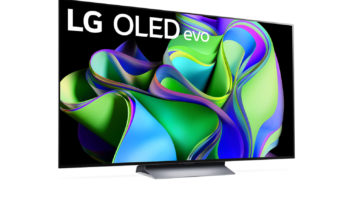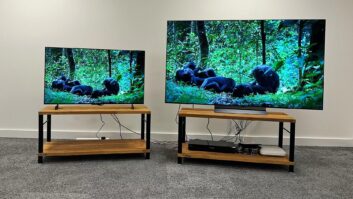LG is expanding high dynamic range (HDR) technology to all of its new 4K OLED and 4K LCD TVs, launching a new upper tier of 4K LCD TVs called Super UHD TVs, and expanding its selection of Ultra HD 4K OLED TVs to eight from four.
A total of 13 Super UHD LCD TVs, available in three series with screen sizes from 49 to 86 inches, will deliver multiple picture enhancements, including an expanded color gamut that hits 91 percent of DCI-P3 color-gamut levels on nine models and 84 percent on four models. DCI-P3 performance is delivered by digital cinemas.
The Super UHD TVs will, like OLED TVs, also be compatible with next-generation widegamut Rec 2020 content, mapping the content accurately to the displays’ capabilities without color distortion, the company said.
The eight new 4K OLED TVs deliver color gamut at 99 percent of P3 levels. They’ll also sport thinner profiles with depths as little as 4.4mm at their slimmest point. They’re part of LG’s “categorization of OLED” beyond a single offering to a selection of models that includes curved-and flat-screen TVs, 4K TVs, and FullHD TVs, said Tim Alessi, head of new product development for home entertainment in the U.S.
At press time, it wasn’t certain whether the new Super UHD TVs and 4K OLED TVs would meet all of the Ultra HD Alliance’s 4K performance criteria.
In other developments, the company said it is:
• drastically scaling back its selection of 1080p FullHD TVs, probably limiting FullHD screen sizes to a maximum of 55 inches.
• and holding off the launch of an Ultra HD Blu-ray player until the second half at the earliest if it decides to launch in 2016, the company said.
Here’s what the company’s 2016 4K TV lineup will look like:
High dynamic range: All 4K LCD and 4K OLED TVs will feature HDR 10 (Open HDR) technology and HDR-compatible HDMI 2.0a inputs. With the inputs, the TVs will accept 4K HDR content from external sources such as 4K Blu-ray players. The TVs will also display Open HDR content from 4K streaming services accessed through the TVs’ apps.
The OLED models will deliver the highest dynamic range. The 4K LCD TVs will deliver HDR content with varying levels of dynamic range depending on brightness specs that weren’t finalized at press time. HDR widens the contrast range between the brightest highlights and the deepest blacks, delivering picture details within the contrast extremes.
HDR 10 “will be the main system to cover any content out there,” said Alessi, but LG is “always looking” at alternative HDR technologies from Dolby and Philips. It’s not certain if the company’s new HDR-compatible TVs can be upgraded to add the Dolby Vision or Philips technologies, he said at press time.
4K OLED TVs: Each of four new 4K OLED series – B6, C6, E6 and the top-end G6 – will offer two screen sizes, with the top series offering 77-and 65-inch screens. The other series offer 55-and 65-inch screens. Last year’s 4K OLED line also ran up to 77 inches.
The OLED models will offer 14 percent wider color gamut than their predecessors, delivering 99 percent of the P3 color-gamut standard, said Alessi. They also deliver wider dynamic range compared to high-end LCD TVs, he said.
With design in mind, the two OLED G6 TVs will feature what Alessi called “wallpaper screens,” and the two E6 series TVs will feature “crystal” back covers. The two models in the C6 series will feature curved screens, and the two D B6 models will feature “bladeslim” flat screens. Additional details of the designs were unavailable.
A 55-inch FullHD EG9100 OLED TV will be carried over.
Super UHD LCD TVs: This tier of 4K LCD TVs will deliver picture enhancements including higher brightness levels, wider color gamut, and higher contrast ratios. A new IPS display reduces glare by 40 to 50 percent depending on the model.
A Color Prime Pro video engine in the flagship UHD9500 series and in the UHD8500 series produces 91 percent of the DCI-P3 color-gamut standard and 125 percent of the Rec 709 standard, which is delivered by Blu-ray discs. The Color Prime engine in the UH7700 series delivers 84 percent of the DCI-P3 standard and 110 percent of the Rec 709 standard.
All three series feature 240Hz refresh rates, Super Luminance technology to boost brightness by 10 to 30 percent depending on model, and the new IPS display, which also boosts color accuracy by two times during off-angle viewing. The display also delivers a seven-fold improvement in contrast-ratio consistency at off-axis viewing angles.
All also feature local dimming, which enhances black levels, and detail-enhancement technology, which sharpens images. They also use an SDR-to-HDR conversion algorithm said to deliver and HDR experience from SDR content.
The UH9500 series consists of four SKUs with 55-, 65-, 79-, and 86-inch screens. The UH8500 series consists of five SKUs in 49-, 55-, 60-, 65-, and 75-inch sizes. And the four models in the UH7700 series come with 49-, 55-, 60-, and 65-inch screens.
UHD LCD TVs: Three series of 4K UHD TVs lack many of the technologies in the Super UHD suite of technologies. One of the new series uses the new IPS display, and two use the Color Prime engine. All feature 120Hz refresh rates.
The top series is the UH7500 series with five models from ranging from 43 to 65 inches. Under that is the six-SKU UH6500 series with 43-to 75-inch screens. And the opening-price series is the five-SKU UH6100 series with 43-to 65-inch screens.
In other comments, the company said it is using You-Tube’s VP9 codec throughout its 4K lineup to stream YouTube’s 4K and HD content.
OLED advantages: OLED TVs have the potential to deliver a brightness range equivalent to 20 f stops, with each f stop representing a doubling in brightness, to deliver a dynamic range of 0.0008 nits to 500 nits. That translates into a 1,000,000:1 contrast ratio, also with the ability to control the individual brightness levels of each of 8.3 million pixels, he said.
In contrast, LCD typically delivers a range of 12 f stops from about 0.25 to 1,024 nits for a contrast ratio of 5,000:1. Though LCD can deliver brighter brights, it can’t deliver the deepest darks, so LCD’s dynamic range is more constrained than OLED’s, he said.
Other OLED advantages include consistent image quality “from any angle” because self-emitting OLED panels require no separate light source, the company said. OLED also delivers a consistent color reproduction rate from dark to bright scenes because of a lack of light leakage. The display technology also provides design flexibility, allowing for thinner displays and curved displays without a loss of picture quality, the company contended.













